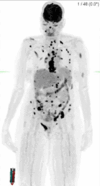Radiographical bony lesions after discontinuation of immunosuppressant therapy: bone involvement in sarcoidosis
- PMID: 38670568
- PMCID: PMC11057273
- DOI: 10.1136/bcr-2023-255611
Radiographical bony lesions after discontinuation of immunosuppressant therapy: bone involvement in sarcoidosis
Abstract
We describe a patient who had failed renal transplant after 13 years, eventually requiring a graft nephrectomy and discontinuation of immunosuppressive therapy, including antithymocyte globulin, tacrolimus and mycophenolate while on steroid avoidance protocol. Within a few months of complete discontinuation of the immunosuppressive medications, she developed lower back pain associated with numbness in her right anterolateral thigh. The radiological imaging demonstrated multiple bony lesions throughout her axial and appendicular skeleton with normal pulmonary findings. A computerised tomography-guided bone biopsy from the left iliac crest revealed fragments of bone with granulomatous inflammation, thus making the diagnosis of extrapulmonary sarcoidosis. Initiating treatment with prednisone resulted in near-complete resolution of symptoms. Long-term immunosuppressive therapy is administered to all renal transplant recipients to help prevent acute rejection and loss of renal allograft. This case highlights that immunosuppressants can conceal the presence of underlying conditions in transplant patients.
Keywords: General practice / family medicine; Radiology; Rheumatology.
© BMJ Publishing Group Limited 2024. Re-use permitted under CC BY-NC. No commercial re-use. See rights and permissions. Published by BMJ.
Conflict of interest statement
Competing interests: None declared.
Figures




Similar articles
-
Administration of Antithymocyte Globulin (Rabbit) to Treat a Severe, Mixed Rejection Episode in a Pregnant Renal Transplant Recipient.Pharmacotherapy. 2016 Apr;36(4):e18-22. doi: 10.1002/phar.1725. Epub 2016 Apr 13. Pharmacotherapy. 2016. PMID: 26892892
-
Calcineurin inhibitor-free immunosuppression in pediatric renal transplantation: a viable option?Paediatr Drugs. 2011 Feb 1;13(1):49-69. doi: 10.2165/11538530-000000000-00000. Paediatr Drugs. 2011. PMID: 21162600 Review.
-
Long-term kidney allograft function and survival in prednisone-free regimens: tacrolimus/mycophenolate mofetil versus tacrolimus/sirolimus.Clin J Am Soc Nephrol. 2012 Mar;7(3):504-12. doi: 10.2215/CJN.06940711. Epub 2012 Jan 26. Clin J Am Soc Nephrol. 2012. PMID: 22282478 Free PMC article. Clinical Trial.
-
Tacrolimus in pancreas transplantation: a multicenter analysis. Tacrolimus Pancreas Transplant Study Group.Clin Transplant. 1997 Aug;11(4):299-312. Clin Transplant. 1997. PMID: 9267719 Clinical Trial.
-
Treatment strategies to minimize or prevent chronic allograft dysfunction in pediatric renal transplant recipients: an overview.Paediatr Drugs. 2009;11(6):381-96. doi: 10.2165/11316100-000000000-00000. Paediatr Drugs. 2009. PMID: 19877724 Review.
References
Publication types
MeSH terms
Substances
LinkOut - more resources
Full Text Sources
Medical
